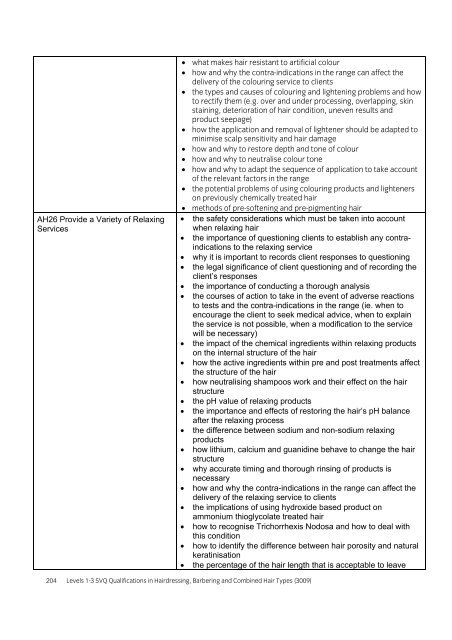3009 SVQ Assessment handbook v2 - City & Guilds
3009 SVQ Assessment handbook v2 - City & Guilds
3009 SVQ Assessment handbook v2 - City & Guilds
Create successful ePaper yourself
Turn your PDF publications into a flip-book with our unique Google optimized e-Paper software.
AH26 Provide a Variety of Relaxing<br />
Services<br />
• what makes hair resistant to artificial colour<br />
• how and why the contra-indications in the range can affect the<br />
delivery of the colouring service to clients<br />
• the types and causes of colouring and lightening problems and how<br />
to rectify them (e.g. over and under processing, overlapping, skin<br />
staining, deterioration of hair condition, uneven results and<br />
product seepage)<br />
• how the application and removal of lightener should be adapted to<br />
minimise scalp sensitivity and hair damage<br />
• how and why to restore depth and tone of colour<br />
• how and why to neutralise colour tone<br />
• how and why to adapt the sequence of application to take account<br />
of the relevant factors in the range<br />
• the potential problems of using colouring products and lighteners<br />
on previously chemically treated hair<br />
• methods of pre-softening and pre-pigmenting hair<br />
• the safety considerations which must be taken into account<br />
when relaxing hair<br />
• the importance of questioning clients to establish any contraindications<br />
to the relaxing service<br />
• why it is important to records client responses to questioning<br />
• the legal significance of client questioning and of recording the<br />
client’s responses<br />
• the importance of conducting a thorough analysis<br />
• the courses of action to take in the event of adverse reactions<br />
to tests and the contra-indications in the range (ie. when to<br />
encourage the client to seek medical advice, when to explain<br />
the service is not possible, when a modification to the service<br />
will be necessary)<br />
• the impact of the chemical ingredients within relaxing products<br />
on the internal structure of the hair<br />
• how the active ingredients within pre and post treatments affect<br />
the structure of the hair<br />
• how neutralising shampoos work and their effect on the hair<br />
structure<br />
• the pH value of relaxing products<br />
• the importance and effects of restoring the hair’s pH balance<br />
after the relaxing process<br />
• the difference between sodium and non-sodium relaxing<br />
products<br />
• how lithium, calcium and guanidine behave to change the hair<br />
structure<br />
• why accurate timing and thorough rinsing of products is<br />
necessary<br />
• how and why the contra-indications in the range can affect the<br />
delivery of the relaxing service to clients<br />
• the implications of using hydroxide based product on<br />
ammonium thioglycolate treated hair<br />
• how to recognise Trichorrhexis Nodosa and how to deal with<br />
this condition<br />
• how to identify the difference between hair porosity and natural<br />
keratinisation<br />
• the percentage of the hair length that is acceptable to leave<br />
204 Levels 1-3 <strong>SVQ</strong> Qualifications in Hairdressing, Barbering and Combined Hair Types (<strong>3009</strong>)
















